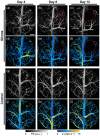High spatiotemporal mapping of cortical blood flow velocity with an enhanced accuracy
- PMID: 38633086
- PMCID: PMC11019678
- DOI: 10.1364/BOE.520886
High spatiotemporal mapping of cortical blood flow velocity with an enhanced accuracy
Abstract
Cerebral blood flow velocity is one of the most essential parameters related to brain functions and diseases. However, most existing mapping methods suffer from either inaccuracy or lengthy sampling time. In this study, we propose a particle-size-related calibration method to improve the measurement accuracy and a random-access strategy to suppress the sampling time. Based on the proposed methods, we study the long-term progress of cortical vasculopathy and abnormal blood flow caused by glioma, short-term variations of blood flow velocity under different anesthetic depths, and cortex-wide connectivity of the rapid fluctuation of blood flow velocities during seizure onset. The experimental results demonstrate that the proposed calibration method and the random-access strategy can improve both the qualitative and quantitative performance of velocimetry techniques and are also beneficial for understanding brain functions and diseases from the perspective of cerebral blood flow.
© 2024 Optica Publishing Group.
Conflict of interest statement
The authors declare no conflicts of interest.
Figures




Similar articles
-
[Standard technical specifications for methacholine chloride (Methacholine) bronchial challenge test (2023)].Zhonghua Jie He He Hu Xi Za Zhi. 2024 Feb 12;47(2):101-119. doi: 10.3760/cma.j.cn112147-20231019-00247. Zhonghua Jie He He Hu Xi Za Zhi. 2024. PMID: 38309959 Chinese.
-
Contrast Gradient-Based Blood Velocimetry With Computed Tomography: Theory, Simulations, and Proof of Principle in a Dynamic Flow Phantom.Invest Radiol. 2016 Jan;51(1):41-9. doi: 10.1097/RLI.0000000000000202. Invest Radiol. 2016. PMID: 26309186
-
Recording human electrocorticographic (ECoG) signals for neuroscientific research and real-time functional cortical mapping.J Vis Exp. 2012 Jun 26;(64):3993. doi: 10.3791/3993. J Vis Exp. 2012. PMID: 22782131 Free PMC article.
-
Advances in laser speckle imaging: From qualitative to quantitative hemodynamic assessment.J Biophotonics. 2024 Jan;17(1):e202300126. doi: 10.1002/jbio.202300126. Epub 2023 Oct 3. J Biophotonics. 2024. PMID: 37545037 Review.
-
Mapping of the neuronal networks of human cortical brain functions.Adv Tech Stand Neurosurg. 2003;28:91-142. doi: 10.1007/978-3-7091-0641-9_2. Adv Tech Stand Neurosurg. 2003. PMID: 12627809 Review.
References
LinkOut - more resources
Full Text Sources
